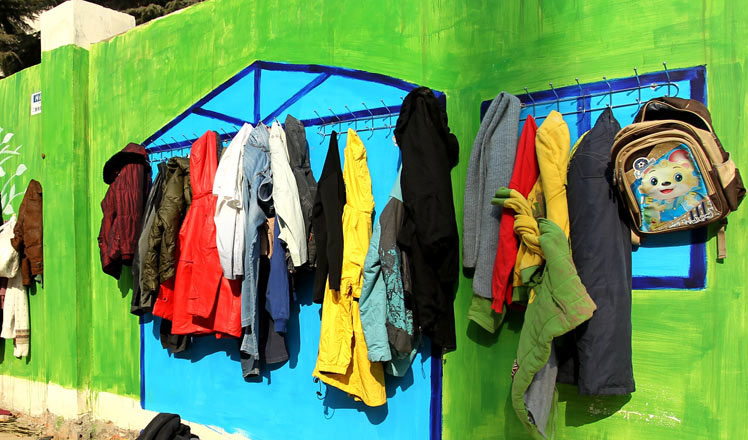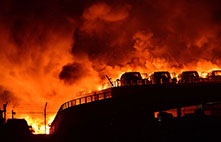Most cities report poor air quality for 2015
Updated: 2016-02-05 03:12
By ZHENG JINRAN(China Daily)
|
||||||||
Most cities out of more than 330 monitored saw their annual air quality readings fall below national safety standards last year, the national environmental authority said on Thursday.
Just 21 percent of the 338 cities had air quality that surpassed the national standards — mainly in southern and western regions.
The vast majority of northern cities still faced severe pollution, according to a report by the Ministry of Environmental Protection.
The 73 cities with good air quality were located mainly in Fujian, Guangdong and Yunnan provinces and in the Tibet autonomous region, the report said.
In contrast, seven of the bottom 10 were in the northern province of Hebei, with the city of Baoding ranking last.
In the Beijing-Tianjin-Hebei region, the 13 cities monitored reported that air quality met national standards for 52.4 percent of the year, meaning that for the rest of the time residents had to contend with light or severe smog.
Soaring coal consumption to fuel heating systems during the winter was the main factor in the regional deterioration of air quality, said Luo Yi, head of the ministry’s Environmental Monitoring Bureau.
Smog affected the trilateral region five times in winter, with the concentration levels of PM2.5 increasing by 9.6 percent year-on-year, the ministry said, adding that Baoding saw severe smog for eight consecutive days.
In Beijing, the PM2.5 concentration level soared by 75.9 percent year-on-year from Nov 15, when the heating service started, until the end of the year.
But for the nation as a whole, air quality improved last year and the concentration levels of three major airborne pollutants — sulfur dioxide, nitrogen dioxide and PM10 — fell by at least 6.3 percent, Luo said.
The average concentration levels of PM2.5 and PM10 in the 338 cities monitored fell by more than 11 percent year-on-year, the report said.
For the 74 major cities, 11 reported good air quality, three more than in 2014. Of these cities, air quality better than the national standard was reported on 71.2 percent of the days last year, demonstrating that efforts to control air pollution had worked, the ministry said.
“But in the north, we have more problems when it comes to improving air quality,” Luo said, adding that curbing pollution this year is still a priority for the governments concerned.
The ministry said the Beijing-Tianjin-Hebei region has launched a pilot project involving an emergency response to smog. The project took effect on Thursday and will end on March 31.
Cities in the trilateral region will take the same emergency actions under unified alert levels, the ministry said in a statement.
When smog affected the region in December, different cities adopted different emergency responses to the severe pollution.
The ministry has told cities in the region to make joint efforts to control air pollution, which will be a more efficient system, the statement said. It added that the core cities of Beijing, Tianjin, Tangshan, Baoding, Langfang and Cangzhou will take the lead on this.
After the pilot project, the joint emergency response system will be expanded to more cities, the ministry said.
- 20 percent of cities exceed air quality standards, mostly in South China
- Beijing looks to meet water consumption goals with recycled supplies
- Excessive emissions a big problem in 59 cities
- More funds to improve air quality
- Severe smog causes over half of China's major cities to fail December standards
- UN special envoy announces temporary pause of intra-Syrian talks
- Taliban kill 10-year-old hailed as militia hero
- Obama slams anti-Muslim rhetoric during first visit to US mosque
- Australian police suspect overseas hackers behind threats to schools
- EU reform proposals show 'real progress': British PM
- Mainland Chile confirms first 3 cases of Zika virus

 Kindness walls bringing extra warmth to the needy
Kindness walls bringing extra warmth to the needy
 A robot that grabs red envelopes
A robot that grabs red envelopes
 Culture Insider: 9 things you may not know about Start of Spring
Culture Insider: 9 things you may not know about Start of Spring
 Talented artist makes tiny pencil lead sculptures
Talented artist makes tiny pencil lead sculptures
 Ten most heartwarming stories about Spring Festival Rush
Ten most heartwarming stories about Spring Festival Rush
 China's 'Moon Walker' sends back stunning HD photos
China's 'Moon Walker' sends back stunning HD photos
 Starbucks, office rents and CEOs form alternative outlook on China
Starbucks, office rents and CEOs form alternative outlook on China
 China's most beautiful wetlands
China's most beautiful wetlands
Most Viewed
Editor's Picks

|

|

|

|

|

|
Today's Top News
National Art Museum showing 400 puppets in new exhibition
Finest Chinese porcelains expected to fetch over $28 million
Monkey portraits by Chinese ink painting masters
Beijing's movie fans in for new experience
Obama to deliver final State of the Union speech
Shooting rampage at US social services agency leaves 14 dead
Chinese bargain hunters are changing the retail game
Chinese president arrives in Turkey for G20 summit
US Weekly

|

|







